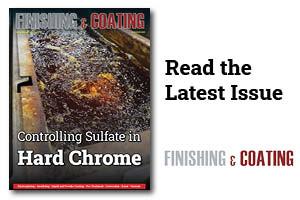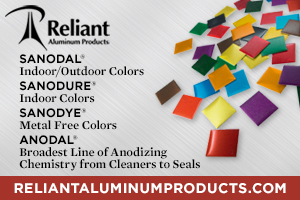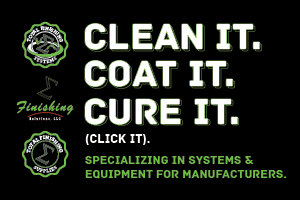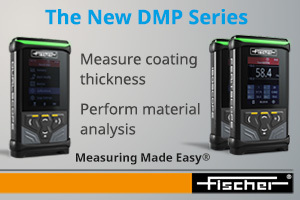A catalyst is defined as a material that increases the rate of a chemical reaction without undergoing any permanent change itself.
 Eric Svenson Sr.The sulfate ion (SO4) is a catalyst in hexavalent chromium baths. Without it, chromium metal (Cr) would not be deposited on the workpiece, and the only reaction would be the evolution of hydrogen and oxygen gas from the breakdown of water by electrolysis. What makes sulfate a true catalyst is the fact that it is not consumed in the electrochemical reaction.
Eric Svenson Sr.The sulfate ion (SO4) is a catalyst in hexavalent chromium baths. Without it, chromium metal (Cr) would not be deposited on the workpiece, and the only reaction would be the evolution of hydrogen and oxygen gas from the breakdown of water by electrolysis. What makes sulfate a true catalyst is the fact that it is not consumed in the electrochemical reaction.
An early reference to sulfate as a catalyst was published by George Dubpernell in 1901. However, scientists today are still unable to determine exactly how it works, other than that it affects the cathodic diffusion layer when DC electricity is applied.
Like so many other developments, the sulfate catalyst was discovered by accident in 1856. Research conducted around 1914 then determined the ideal level of sulfate needed for obtaining reliable chromium deposits.
Sulfate Concentration
There’s no specific amount of sulfate needed in the chrome bath; rather, it varies as a ratio to the chromic acid concentration. The typical ratio for the standard (Sargent) bath is 100:1. For example, if the chromic acid were 30 oz/gallon, then the sulfate should be 0.30 oz/gal, or 0.40 for a 40 oz/gal bath, etc. This has been a convenient and useful standard, but some variations are beneficial for specific circumstances. In general, though, the 100:1 ratio for the standard bath provides a useful chromium deposit; its only shortcomings include:
- Low plating speed and efficiency
- High amount of chrome misting
- A poor microcrack structure
- Sensitivity to typical bath impurities
Improvements have been made over the years to include using various amounts of fluorides and other additives. The past decade has seen significant improvement to the old standard 100:1 bath with the introduction of new organic secondary catalysts, buffers, and chelators that work in conjunction with sulfate.
The ideal sulfate ratio varies with bath type and the other additives used. Technical literature for those baths should be consulted for their optimum sulfate ratio and the range.
The ratio is much more important than the actual concentration. The standard and the newer dual and triple catalyst baths, like Dura-3000, can operate with a sulfate ratio of 75:1 – 130:1, while the high fluoride catalyzed baths generally require a 190:1 – 260:1 ratio depending on the bath type. Those are the general ranges, whereas each bath type will have a specific ratio for obtaining the best performance.
In general, varying the sulfate ratio will have the following effects:
| High Sulfate – Low Ratio | Low Sulfate – High Ratio |
| Reduced throwing power | Poor coverage |
| Hazy deposits | Dull deposits |
| Macrocracking tendency | Finer crack structure |
| Narrower bright range | Dull spots in HCD areas |
| Greater pitting tendency | Iridescence around holes |
| Rougher deposits | Nodular deposits |
| Softer deposits | Fish scales & half-moon pits |
| White patches if extreme | Brown stains in low CD areas |
| Less hydrogen embrittlement | Gray deposits; but very smooth |
| Better iron and copper tolerance | Milky colored deposits |
| Faster plating speeds | Burning and white spots in HCD |
Changes to the deposit are proportional to the sulfate variance from its norm. As a note, a high ratio means the sulfate is low relative to the chromic acid content at that time. A 30 oz/gal bath with 0.20 sulfate would have a 150:1 ratio, which may be high for that application. At the same time, that 30 oz/gal bath with 0.40 sulfate would have a ratio of 75:1, which might be low.
Ratio Optimization
The desired ratio of 100:1 for the old standard bath, or another ratio for the newer, higher-performance baths, may or may not be ideal for any particular application. Different plating set-ups may have peculiarities that see better overall performance using a somewhat different ratio than what’s recommended. This is especially true for operations that plate the same type of part in a dedicated tank where the current density stays relatively uniform. Plating shafts and cylinders is a good example of this.
Ratio experimentation is encouraged in these situations by varying it by 20-30% from the recommended amount. This fine-tuning of the ratio may show significant improvement for that particular application. It is suggested to start with a low sulfate (high ratio) and gradually increase it in small steps while noticing changes to the deposit properties. Starting low and gradually increasing it is considerably easier than starting high and lowering it. At some point, an obvious perfect ratio will be observed for that part in that operation. This ratio would then become the desired control point.
New Bath Make-Ups
It is suggested to never make up a fresh bath using 100% of the calculated sulfate addition because of sulfate impurities in the ingredients used. Doing so will virtually guarantee an initial high sulfate content. It’s much better to only add 90% of the sulfate initially and then have a sample tested so the final addition can be determined. This will get you started with the correct ratio and avoid having to make an undesirable barium addition.
Sources of Sulfate
There are only two sources of sulfate suitable for hard chrome plating. These are 1) Sulfuric Acid (H2SO4 in various forms) and 2) Buffered Sulfate Adjuster. Here are the pros and cons of each:
Sulfuric Acid (H2SO4)
Sulfuric acid is available in many types and concentrations. It’s important to only use the reagent and not the commercial grade because that’s used for acid pickling and contains high levels of iron and other impurities that are harmful to the chrome bath. The reagent grade is much purer and doesn’t have these contaminants.
Next in importance is its concentration, which should be 66° Be’ or 1.835 SG; this is the highest concentration that’s available commercially. An option is using a 50% by volume dilution of the 1.835 SG material.
While sulfuric acid is effective as a sulfate source, it also presents several hazards and problems. Refer to the Caution comments in Increasing Sulfate below. Its main problems include:
- It’s a very strong acid and can easily cause burns.
- It’s exothermic and dangerous to add to the bath.
- It is difficult to measure accurately; minor mistakes have a huge impact.
Buffered Sulfate Adjuster
This is a powdered sulfate additive that offers significant advantages over using sulfuric acid.
- It is non-corrosive and much safer to handle and work with.
- It isn’t exothermic and can be safely added to the bath.
- It is much easier to accurately measure.
- Its buffering action helps mitigate bath impurities.
Sulfate Build-Up
As mentioned, the sulfate ion is not consumed during electrolysis. Because of this, it can never be reduced in the bath unless the tank is diluted from a leak or a decant. This means that the sulfate concentration always increases over time, creating a lower ratio, due to the impurities present in the various bath additions.
The two primary sources of excess sulfate are the plant water supply and the chromic acid that’s used. Other sulfate sources can be drag-in from a previous bath containing sulfate or the breakdown of non-permanent fume suppressants. It can also increase from inappropriate and unnecessary sulfuric acid additions by the plater. Sulfate additions should be made based only on a bath analysis, never by speculating that it might be needed.
Most high-quality chrome operations have a water purification system that removes both anionic and cationic impurities by using a reverse osmosis and ion exchange (RO/DI) system. This is needed even if ‘purified’ city water is used. The operations that use city water straight from the spigot will experience a faster build-up of sulfate and will struggle with maintaining the desired ratio.
The other sulfate culprit is the brand of chromic acid that’s used. All brands include some sulfate, in various degrees, as an impurity because sulfuric acid is used in the conversion process of chromium ore into chromium trioxide (aka chromic acid). The chromate producers purify their material to remove as much sulfate as they can. Some are better than others, but even the best brands still leave a trace of sulfate in their product.
The best chromic acid to use is HCP Grade, which has as little as 0.01% sulfate, while others have 0.25% or more. It’s recommended to use only the high-purity HCP grade, as other brands have impurity levels that continually accumulate, causing plating problems and a shorter bath life.
Testing for Sulfate
 Sulfate Centrifuge and Timer.Hard chrome operations should have the ability to control both their chromic acid and sulfate concentrations in-house using reliable and accurate test methods. These tests allow for better monitoring of the ratio and provide ideal process control. The objective is to maintain these bath ingredients within a +/- 2-5% variance; obviously, the 2% variance is preferred.
Sulfate Centrifuge and Timer.Hard chrome operations should have the ability to control both their chromic acid and sulfate concentrations in-house using reliable and accurate test methods. These tests allow for better monitoring of the ratio and provide ideal process control. The objective is to maintain these bath ingredients within a +/- 2-5% variance; obviously, the 2% variance is preferred.
Doing these tests once a week is adequate for most typical operations. Only those tanks exceeding 200 amp. Hours per bath and gallons per week may require more frequent testing.
Using a vendor’s laboratory for back-up analysis is also advised, but this shouldn’t be the primary control method. Outside laboratories are best used to confirm the in-house results and to test for bath impurities. A reliable laboratory that specializes in hard chrome technology should be used.
 Accuracy Grade Sulfate Tubes.A small in-house laboratory using accurate grade equipment, glassware, reagents, and procedures is inexpensive, given the value this brings to the operation. Once trained, the operator should be able to complete the testing in well under an hour. There’s great value in adopting the same test methods used by the qualified laboratory that you send your back-up samples to.
Accuracy Grade Sulfate Tubes.A small in-house laboratory using accurate grade equipment, glassware, reagents, and procedures is inexpensive, given the value this brings to the operation. Once trained, the operator should be able to complete the testing in well under an hour. There’s great value in adopting the same test methods used by the qualified laboratory that you send your back-up samples to.
Inexpensive test kits are not adequate for this, and hydrometers or Baume’s tests should not be used for checking the chromic acid concentrations. The chromic acid level should be tested using a titration against a known chromium standard.
The sulfate is best tested using a centrifuge to measure the volume of the sulfate precipitate, which is then read as oz s per gallon of sulfate (SO4) using special accuracy grade centrifuge tubes. This test can be performed quickly and with high reliability. The more complicated and time-consuming tests, such as gravimetric, ion chromatographic, and others, are not needed.
One caution on the sulfate test reagents used is that the common A and B solutions do not provide the needed accuracy and often lead to costly errors. Instead, it’s important to use the reagents supplied by a reliable laboratory, which can also provide the equipment, the recommended procedure, and the training needed.
The ratio is obtained by simply dividing the chromic acid concentration by the sulfate concentration, both in ozs per gallon.
Ratio Adjustments
The goal is to maintain the desired chrome/sulfate ratio in the process. Chromic acid is consumed during plating and is replaced with regular bath additions. As mentioned earlier, the sulfate acts as a true catalyst and is not consumed; instead, it increases due to impurities in the ingredients used, primarily the water supply and the chromic acid. The ratio, therefore, gradually decreases as the sulfate builds over time. This can throw the process out of kilter, so a decision is needed on how to best correct the ratio and bring it back in line. There are two alternatives to consider:
- Increasing the chromic acid level, or
- Lowering the sulfate level.
Increasing the chromic acid level is the easiest and least time-consuming method. But, there’s a practical issue of how high is too much. In general, exceeding the chromic acid target level by more than 20% is not recommended. Most operations prefer maintaining the same chromic acid level and lowering the sulfate to rebalance their ratio.
New options are now available that eliminate the need for frequent barium additions due to ongoing sulfate increases. Because of the variables, these are best provided on an as-needed basis.
Increasing Sulfate
The most effective method for increasing the sulfate level is by adding a Buffered Sulfate Adjuster. A less desirable option is using reagent sulfuric acid in various concentrations. Note, however, that a sulfate addition is rarely needed unless it’s for making up a fresh bath. Always question a low sulfate reading by performing a second analysis. A tank leak or an inadvertent barium addition is the only reason that a sulfate addition would be needed.
The following are the formulas needed to calculate sulfate additions:
Buffered Sulfate Adjuster
| Amount Required | Calculation |
| In Pounds: | oz/gal sulfate increase x bath gallons x 0.11075 |
| In Grams: | oz/gal sulfate increase x bath gallons x 50.2354 |
Notes: a) Use an accurate scale to measure this; b) Only add 90% of this for a fresh bath make-up; c) Multiply by 16 to convert the pounds decimals to ounces.
Using the Buffered Sulfate Adjuster is the preferred method because it’s much safer to handle, isn’t overly hazardous, and won’t boil back in the operator’s face when added to a hot solution. It also helps to buffer the bath against the effects of impurities.
The least desirable method of increasing sulfate is using reagent-grade sulfuric acid because of the dangers involved. Do not use the commercial grade because of its high levels of iron and other impurities. Use extreme caution when handling sulfuric acid if it must be used.
Reagent Sulfuric Acid – 1.835 S.G.
| Amount Required | Calculation |
| In Pounds: | oz/gal sulfate increase x bath gallons x 0.11075 |
| In Grams: | oz/gal sulfate increase x bath gallons x 50.2354 |
Notes: a) Use an accurate scale to measure this; b) Only add 90% of this for a fresh bath make-up; c) Multiply by 16 to convert the pounds decimals to ounces.
Caution: Adding sulfuric acid to a chrome bath can be extremely hazardous; it’s highly corrosive and can cause severe burns. It is also exothermic and generates excessive heat when added to water or the chrome bath. That reaction is so violent that the acid and the bath can literally boil back into the operator’s face if they are not careful. This danger is magnified considerably if the bath is already hot at the operating temperature of 130-140° F. If sulfuric acid must be used, it’s best added when the bath is at room temperature and under heavy agitation. Then very slowly pour in the measured amount of sulfuric acid, spreading it evenly across the bath’s surface. Never, ever dump it in quickly in one spot, as this is guaranteed to cause the very dangerous exothermic boil back. When completed, allow it to mix for 30 minutes of agitation and then take a bath sample for a sulfate test. The exothermic hazard is reduced when using 50% sulfuric acid by volume, but the same precautions must still be followed.
Decreasing Sulfate
The best method for decreasing the sulfate level is by adding barium carbonate (BaCO3) to the bath. The barium reacts with the excess sulfate, creating barium sulfate, which is insoluble and precipitates out of solution. The carbonate is released as a gas into the atmosphere. Certain other barium compounds can be used, but barium carbonate has proven to be the best option. Never use barium hydroxide as this changes the bath’s pH and the cathodic film, which can result in deposit pitting.
The barium sulfate is a fine white silt that’s tainted yellow from the chrome. It’s insoluble and settles to the bottom of the tank unless disturbed by agitation. The following formula is used for calculating the amount of barium carbonate to use.
Barium Carbonate
| Amount Required | Calculation |
| In Ounces: | oz/gal sulfate decrease x bath gallons x 2.2 |
| In Pounds: | oz/gal sulfate decrease x bath gallons x 0.1375 |
Notes: a) Barium carbonate additions must be precise. Never guess and use an accurate scale for this; b) Multiply by 16 to convert the pounds decimals to ounces.
There are three ways to handle a barium treatment, each has its pros and cons:
Direct Bath Addition: The barium carbonate is added directly to the tank. This is the most common, easiest, and fastest method, but also the least recommended because the precipitate stays in the bath and can cause deposit roughness. Most of it settles to the tank bottom, unless agitation prevents this, but some of it is invariably disturbed by the movement of the solution. Any barium sulfate sludge thusly formed should be removed from the tank whenever possible.
Using Filter Bags: The barium carbonate is divided equally into several size #2 polypropylene 5-micron filter bags, which are 3/4 suspended in the bath. It’s best to double-bag them to help prevent the precipitate from passing through the material. Then slowly pour or pump the bath into the filter bags until all of the barium has reacted. The barium needs to be stirred occasionally to expose all of it to the plating solution. Always be conscious of avoiding the gasping that occurs. Some of the barium precipitate will escape into the bath because of its very small particle size, but the bulk of it will remain inside the bag. When finished, the bags are rinsed and disposed of as hazardous waste. Never do this in an enclosed filter chamber due to the pressure increase caused by gas liberation.
Partial Bath Treatment: This is the recommended method, but also the most time-consuming and messy. It involves removing some of the bath, which is then treated in a separate tank to remove 100% of the sulfate from that portion of the bath. After settling, the sulfate-free solution is then decanted back into the plating, which dilutes its sulfate to the desired level. A spare tank, a holding tank, or even lined 55-gallon drums can be used for treatment, but never fill them above 80% capacity. This method uses a different calculation than what’s shown above because we first need to calculate the amount of bath to be removed and then the amount of barium carbonate needed to treat that bath portion.
Vigilance is needed regardless of the treatment method used. The barium carbonate is best added to a room-temperature bath using vigorous agitation. Add it slowly and spread evenly over the entire tank surface; never dump it in quickly in a single spot. See the caution below because adding it too quickly will result in a violent reaction that results in chromic acid exposure.
A properly operated and controlled hard chrome bath rarely needs a barium treatment to lower the sulfate, but this requires:
- Purifying the plant’s city water supply.
- Using only HCP Grade chromic acid and other bath chemicals.
- Having an in-house lab to test the basic bath ingredients.
- Proper control of the chromic acid: sulfate ratio.
If, for any reason, frequent barium additions are required, a dedicated barium treatment cell can be designed that greatly reduces the cost, labor, time, and mess involved. This would also increase the safety of those involved.
Caution: The barium carbonate reaction with the plating solution is somewhat violent due to the carbonate gas liberation. This is a serious safety concern because if added too quickly in one spot, it can result in exposure to chromic acid mist, splashes, sprays, and fumes.
Always read and understand the SDS form for any chemical that’s being handled, measured, or added to a plating solution. Be sure to wear the recommended personal protection gear, including a respirator and a face shield, and use an adequate ventilation system.
Technical Assistance: Plating Resources, Inc. can provide further guidance on these treatment methods or review your various options. This can also involve things like troubleshooting approaches, sulfate and ratio control, improving plating efficiency, or even dealing with high impurities in the plating bath. Please contact Vicky at Vicky@Plating.com with any questions or if you wish to further explore these suggestions. www. Plating.com
Eric Svenson Sr. is CEO of Plating Resources and a Master CEF and IUSF member. Visit www.Plating.com. If you have any questions or wish to explore this topic further, please contact Vicky at Vicky@Plating.com.



































